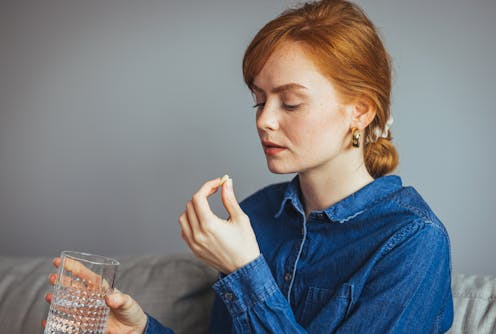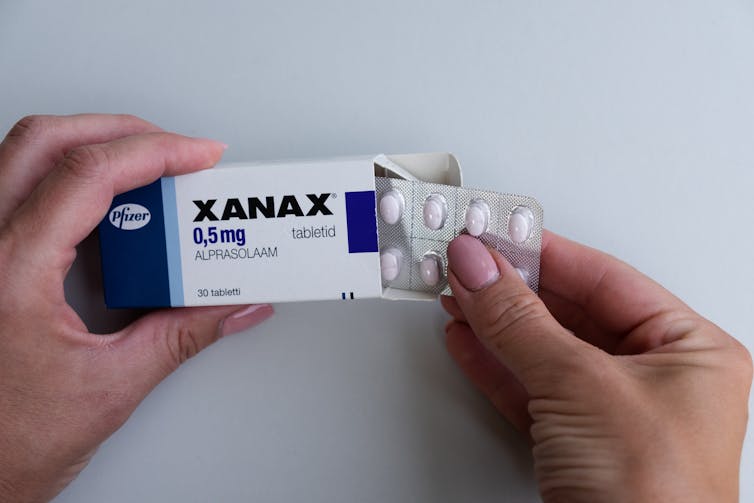
Anecdotal reports from some professionals have prompted concerns about young people using prescription benzodiazepines such as Xanax for recreational use.
Border force detections of these drugs have almost doubled in the past five years, further fuelling the worry.
So why do young people use them, and how do the harms differ to those used as prescribed by a doctor?
What are benzodiazepines?
You might know this large group of drugs by their trade names. Valium (diazepam), Xanax (alprazolam), Normison (temazepam) and Rohypnol (flunitrazepam) are just a few examples. Sometimes they’re referred to as minor tranquillisers or, colloquially, as “benzos”.
They increase the neurotransmitter gamma aminobutyric acid (GABA). GABA reduces activity in the brain, producing feelings of relaxation and sedation.
Unwanted side effects include drowsiness, dizziness and problems with coordination.
Benzodiazepines used to be widely prescribed for long-term management of anxiety and insomnia. They are still prescribed for these conditions, but less commonly, and are also sometimes used as part of the treatment for cancer, epilepsy and alcohol withdrawal.
Long-term use can lead to tolerance: when the effect wears off over time. So you need to use more over time to get the same effect. This can lead to dependence: when your body becomes reliant on the drug. There is a very high risk of dependence with these drugs.
When you stop taking benzodiazepines, you may experience withdrawal symptoms. For those who are dependent, the withdrawal can be long and difficult, lasting for several months or more.
So now they are only recommended for a few weeks at most for specific short-term conditions.
How do people get them? And how does it make them feel?
Benzodiazepines for non-medical use are typically either diverted from legitimate prescriptions or purchased from illicit drug markets including online.
Some illegally obtained benzodiazepines look like prescription medicines but are counterfeit pills that may contain fentanyl, nitazenes (both synthetic opioids) or other potent substances which can significantly increase the risk of accidental overdose and death.
When used recreationally, benzodiazepines are usually taken at higher doses than those typically prescribed, so there are even greater risks.
The effect young people are looking for in using these drugs is a feeling of profound relaxation, reduced inhibition, euphoria and a feeling of detachment from one’s surroundings. Others use them to enhance social experiences or manage the “comedown” from stimulant drugs like MDMA.
There are risks associated with using at these levels, including memory loss, impaired judgement, and risky behaviour, like unsafe sex or driving.
Some people report doing things they would not normally do when affected by high doses of benzodiazepines. There are cases of people committing crimes they can’t remember.
When taken at higher doses or combined with other depressant drugs such as alcohol or opioids, they can also cause respiratory depression, which prevents your lungs from getting enough oxygen. In extreme cases, it can lead to unconsciousness and even death.
Using a high dose also increases risk of tolerance and dependence.
Is recreational use growing?
The data we have about non-prescribed benzodiazepine use among young people is patchy and difficult to interpret.
The National Drug Strategy Household Survey 2022–23 estimates around 0.5% of 14 to 17 year olds and and 3% of 18 to 24 year olds have used a benzodiazepine for non medical purposes at least once in the past year.
The Australian Secondary Schools Survey 2022–23 reports that 11% of secondary school students they surveyed had used benzodiazepines in the past year. However they note this figure may include a sizeable proportion of students who have been prescribed benzodiazepines but have inadvertently reported using them recreationally.
In both surveys, use has remained fairly stable for the past two decades. So only a small percentage of young people have used benzodiazepines without a prescription and it doesn’t seem to be increasing significantly.
Reports of more young people using benzodiazepines recreationally might just reflect greater comfort among young people in talking about drugs and drug problems, which is a positive thing.
Prescribing of benzodiazepines to adolescents or young adults has also declined since 2012.
What can you do to reduce the risks?
To reduce the risk of problems, including dependence, benzodiazepines should be used for the shortest duration possible at the lowest effective dose.
Benzodiazepines should not be taken with other medicines without speaking to a doctor or pharmacist.
You should not drink alcohol or take illicit drugs at the same time as using benzodiazepines.

Counterfeit benzodiazepines are increasingly being detected in the community. They are more dangerous than pharmaceutical benzodiazepines because there is no quality control and they may contain unexpected and dangerous substances.
Drug checking services can help people identify what is in substances they intend to take. It also gives them an opportunity to speak to a health professional before they use. People often discard their drugs after they find out what they contain and speak to someone about drug harms.
If people are using benzodiazepines without a prescription to self manage stress, anxiety or insomnia, this may indicate a more serious underlying condition. Psychological therapies such as cognitive behaviour therapy, including mindfulness-based approaches, are very effective in addressing these symptoms and are more effective long term solutions.
Lifestyle modifications – such as improving exercise, diet and sleep – can also be helpful.
There are also other medications with a much lower risk of dependence that can be used to treat anxiety and insomnia.
Read more: I think my child has anxiety. What are the treatment options?
If you or someone you know needs help with benzodiazepine use, Reconnexions can help. It’s a counselling and support service for people who use benzodiazepines.
Alternatively, CounsellingOnline is a good place to get information and referral for treatment of benzodiazepine dependence. Or speak to your GP. The Sleep Health Foundation has some great resources if you are having trouble with sleep.
Nicole Lee works as a research consultant in alcohol and other drugs. She has previously been awarded grants by state and federal governments, the National Health and Medical Research Council and other public funding bodies for alcohol and other drug research. She is a Board member of The Loop Australia, which runs the Queensland and Victorian drug checking services mentioned.
Suzanne Nielsen receives funding from the Australian National Health and Medical Research Council, the Commonwealth Government. She is the President-elect for the Australasian Professional Society on Alcohol and other Drugs (APSAD), Australasia's leading multidisciplinary organisation for professionals involved in the drug and alcohol field.
This article was originally published on The Conversation. Read the original article.







